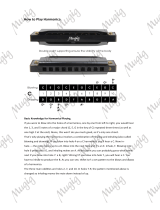Page is loading ...


a
b
BLOW
DRAW
c
e
e
g
1
a
b
c
d
e
f
a
g
c
b
e
d
a
f
d
e
BLOW
DRAW
f
a
a
c
d
e
f
g
a
b
d
c
f
e
a
g
d
b
g
a
BLOW
DRAW
b
d
d
f
g
a
b
c
d
e
g
f
b
a
d
c
g
e
1
1
1 1
1
2
2
2
2
2
2
3
2
3
3
3
3
1
1
1
1
1
1
2
2
2
2
2
2
2
3
3
3
3
c
d
BLOW
DRAW
e
g
g
b
c
d
e
f
g
a
c
b
e
d
g
f
c
a
1
1
1
1
1
2
2
2
2
2
2
2
3
3
3
3
3
3
4
3
1
1
1
1
1
1
2
2
2
2
2
2
3
2
3
3
3
3
4
3
Copyright © 1963 Sony/ATV Music Publishing LLC.
All rights administered by Sony/ATV Music Publishing LLC., 424 Church Street, Suite 1200, Nashville, TN 37219.
All rights reserved. Used by permission. The rights for Japan licensed to Sony Music Publishing (Japan) Inc.
JASRAC
1802151-801
0570
-
666
-
569

Hold the harmonica so that the numbers on the top of the instrument
are as shown in figure 1. It is good practice to have your left hand
fingers cover more of the instrument than your right hand fingers so
that you get accustomed to the hand positions required for vibrato
effects.
10-HOLE DIATONIC INSTRUCTIONS
figure 1
HOLDING FORM

The top harmonica players use effects like vibrato and pitch bending to
express their own musical style in blues, rock and country music.
These effects are not hard to learn and are fun to experiment with.
Cup your hands as shown and start by playing a sustained note while opening and closing your fingers.
You will soon see how the movement and speed of your finger motions produce a vibrato effect and by
experimenting you should be able to produce various effects with a minimum of practice.
This effect consists of changing (de-tuning) the pitch. This is done by changing the tongue position, mouth
position and increasing or decreasing the breath pressure while blowing or drawing. With a minimum of
practice you should be able to bend notes and master this technique.
Position your mouth as if to whistle, and carefully align the round
opening of the lips at the desired tone hole. In this style, the mouth
moves to the desired tone hole and the harmonica is generally herd in a
stationary position.
Position your mouth on the harmonica so that your lips cover 4 tone holes.
Then use your tongue to cover the 3 tone holes on the left side, so that the
4th tone hole (right side) is open. In this style the harmonica is sided to the
right or left while holding your mouth and tongue in the same position.
The harmonica is played by blowing or drawing your breath at the various tone holes. The following chart
shows the positions of the notes of a basic 10 hole harmonica in the key of “C”. You will also notice that as
well as playing single notes, it is possible to blow or draw multiple notes (chords). For example, if the
player was to blow tone holes 1, 2, 3, (#4 is optional) the notes played would be C, E, G (C) or a “C” major
chord. Using this method in various positions with the blow and draw method, rock, blues and other chord
patterns are easy to play and a lot of fun !!
There are 2 ways to play single notes on the harmonica.
Lips
Tongue
1 2 3 4 5
PLAYING
NOTE POSITIONS & RELATIONSHIPS
Whistle Style
Tongue Assist Style
SPECIAL EFFECTS
Vibrato
Pitch Bending
blow
draw
C
1 2 3 4 5 6 7 8 9 10
C E G C E G C CE G
D G B D F A B AD F


/

